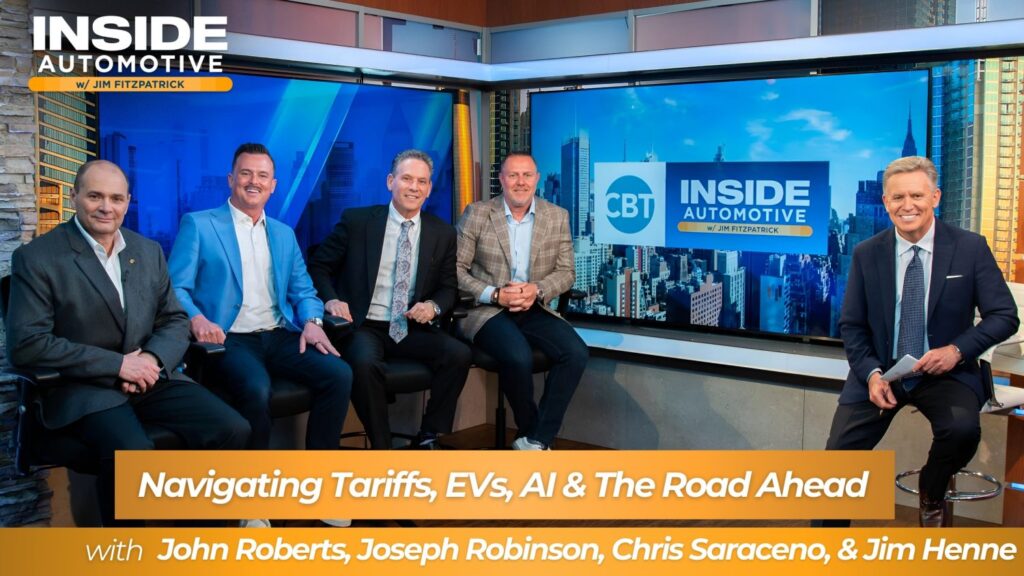In a recent session of Inside Automotive, hosted by Jim Fitzpatrick, four industry veterans gathered to discuss the evolving landscape of automotive retail. The panel included Chris Saraceno of Kelly Auto Group, John Roberts from Roberts Motors Ford, Jim Henne of Performance Motors, and Joseph Robinson of Robinson Toyota. Their conversation covered key topics such as tariffs, electric vehicles, artificial intelligence, and current challenges in the industry.
Tariffs
During the discussion, the topic of tariffs was met with a mix of cautious optimism and concern. While recognizing the immediate hurdles these changes present, the panelists agreed on the potential long-term benefits of bringing production back to the U.S., enhancing supply chain efficiency and independence. They likened the current uncertainties to those experienced during the COVID-19 pandemic, suggesting that with strategic planning, the situation might stabilize more smoothly than anticipated.
Electric Vehicles
The panel voiced skepticism regarding the current state of electric vehicles (EVs), pointing to infrastructure inadequacies, high costs, and limited market demand, particularly in rural areas. Although plug-in hybrids are gaining popularity as a practical compromise, the push for full EV adoption seems driven more by incentives than actual market forces. Concerns were raised about competition from Chinese automakers like BYD, whose affordable, long-range EVs are capturing a growing market share. The use of tariffs is seen as part of a broader strategy to protect U.S. manufacturers from being undercut by these imports.
The Future of Artificial Intelligence
The impact of artificial intelligence (AI) on dealership operations was also a focal point. The panelists highlighted how AI is improving efficiency and customer engagement, with some dealerships already utilizing AI for managing internet leads and service appointments. While AI is not expected to replace core staff, it is likely to streamline business development center operations, reducing the need for larger teams. Tools like ChatGPT are being adopted for messaging and social media tasks, pointing towards a future of more streamlined, tech-driven workflows.
Industry Concerns
Concerns about future profitability, especially for Toyota dealers, were a major topic. Henne and Robinson expressed worries about the brand’s potential return to high-volume models with excessive inventory, which could compress margins. Henne cited past experiences where average net-to-sales ratios were significantly lower compared to current healthier figures. He warned that increased supply could limit reinvestment capabilities.
Saraceno discussed issues with stair-step incentive programs from OEMs, which he argued create pricing inconsistencies and customer confusion. The timing-based eligibility of these incentives was criticized for lacking transparency.
Roberts highlighted the challenge of acquiring quality pre-owned inventory, noting reliance on costly auctions due to a shortage of trade-ins. Despite maintaining a 30-day supply, he mentioned a willingness to expand if more inventory became accessible. Saraceno emphasized the need for diverse sourcing channels, while Robinson pointed out the broader impact of used vehicles on fixed operations and finance and insurance departments.
The consensus was that focusing on vehicle turn rather than just front-end gross is crucial for profitability, as faster turnover increases revenue across various departments.
“We don’t know what we don’t know. Our team should never see us sweating. We should be cheerleaders who say, ‘Listen, our best times are ahead of us. We take care of customers, we take care of our team, and we do the right thing. Good things will happen.’ I believe it’s our job not to panic.”
“You’re in the now. We have to operate with what we know right now and take care of business right now. We’ll deal with whatever gets handed to us. The car business has always been legendary for that. We handle adversity very well.” – John Roberts
“We use AI on the variable and fixed side. Every lead that comes into our store is answered by conversational AI, and it schedules about 400 appointments a month. But, it’s not going to replace people–you need the people there.”– Jim Henne
“It’s a long-term goal. A lot of times, to get to something long-term, it takes some sacrifice. I think we’re in the middle of that sacrifice time. But in a year from now, it may just be something that we talk and laugh about.” – Joseph Robinson
Original Story at www.cbtnews.com
